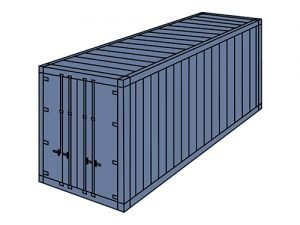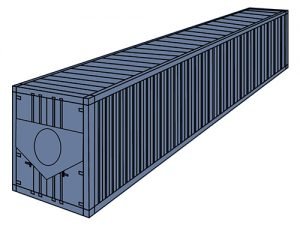20′ DC / 40′ DC
Although these types of containers are referred to as “dry van” or “standard” in some business correspondence, often the term "general purpose" is more appropriate. In accordance with international use, external dimensions may be fixed in terms of length and width, and heights may be different. It has two doors and only one of them can be opened outwards. When the door of the container is closed, it is waterproof and airtight. The material used in container manufacturing is selected considering both the carrying capacity and the volume. Generally,
steel and aluminum are used. Steel containers have less loading capacity because steel is heavier.
20′ OT / 40′ OT
It carries the length and width of a typical general purpose container, with only one difference, it does not have a "fixed top". It is used in cases where loads that are too long / wide to fit into the container from the door can only be placed from the top by crane or similar vehicles. Mostly machines, marble plates, aluminum profiles etc. are transported. Open top containers are often used for overflow loads. It is tightly covered with a canvas after loading. The base is a little thicker because it carries heavy loads, and since it is classified as special equipment, surcharge is usually added to the freight.
20′ Flat Rack / 40′ Flat Rack / 40′ Collapsible Flat Rack
Sometimes it is also called “flat” for short. This type of container does not have two sides and a top. Sometimes both head parts can be dislodged. Since the flat container is suitable for loading goods from both sides and overflows, quite a lot of surcharge can be added to the freight. The bottom of the container is very thick.
40′ High Cube / 45′ High Cube
This type of container is used for the transportation of relatively light but high volume goods. Their height is 30 cm more than the normal 40 ′ container.
40′ Reefer / 40′ High Cube Reefer / 45′ High Cube Reefer
In reefer container transportation service, it is used for the transportation of other loads, especially food products, with a cooling unit installed in the container and operated by an electric or diesel engine, with cooling control.

20' Dry Cargo
| Internal Dimensions | ||
| Length | 5,897 mm | 19 ft 4,17 in |
| Width | 2,348 mm | 7 ft 8,44 in |
| Height | 2,390 mm | 7 ft 9,90 in |
| Door Opening | ||
| Width | 2,336 mm | 7 ft 8,01 in |
| Height | 2,280 mm | 7 ft 5,45 in |
| Weight | ||
| Max Gross | 30,480 kg (24,000 kg) |
67,200 lb (52,210 lb) |
| Tare | 2,240 kg (2,290 kg) |
4,940 lb (5,050 lb) |
| Max Loading | 28,240 kg (21,710 kg) |
62,260 lb (47,860 lb) |
| Loading Volume | 33 cubic meter | 1,165 cubic feet |

40' Dry Cargo
| Internal Dimensions | ||
| Length | 12,031 mm | 39 ft 5,66 in |
| Width | 2,348 mm | 7 ft 8,44 in |
| Height | 2,390 mm | 7 ft 9,90 in |
| Door Opening | ||
| Width | 2,336 mm | 7 ft 8,01 in |
| Height | 2,280 mm | 7 ft 5,45 in |
| Weight | ||
| Max Gross | 32,500 kg (30,480 kg) |
71,650 lb (67,200 lb) |
| Tare | 3,750 kg (3,770 kg) |
8,270 lb (8,310 lb) |
| Max Loading | 28,750 kg (26,710 kg) |
63,380 lb (58,890 lb) |
| Loading Volume | 68 cubic meter | 2,401 cubic feet |

40' High Cube
| Internal Dimensions | ||
| Length | 12,031 mm | 39 ft 5,66 in |
| Width | 2,348 mm | 7 ft 8,44 in |
| Height | 2,695 mm | 8 ft 10,12 in |
| Door Opening | ||
| Width | 2,336 mm | 7 ft 8,01 in |
| Height | 2,585 mm | 8 ft 5,75 in |
| Weight | ||
| Max Gross | 32,500 kg (30,480 kg) |
71,650 lb (67,200 lb) |
| Tare | 3,940 kg (3,990 kg) |
8,690 lb (8,880 lb) |
| Max Loading | 28,750 kg (26,710 kg) |
62,960 lb (58,400 lb) |
| Loading Volume | 76 cubic meter | 2,684 cubic feet |
